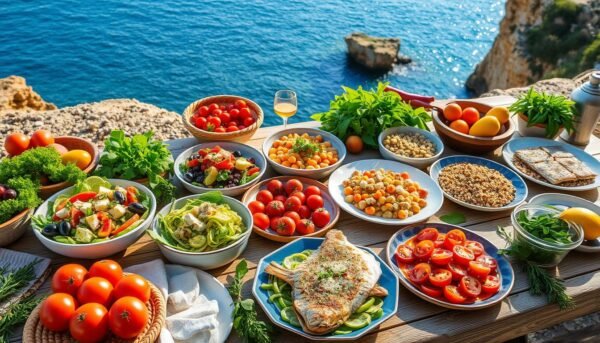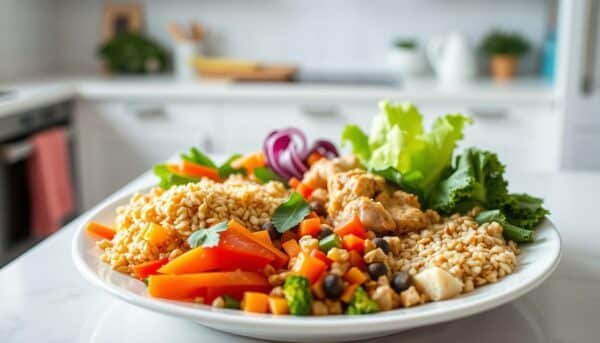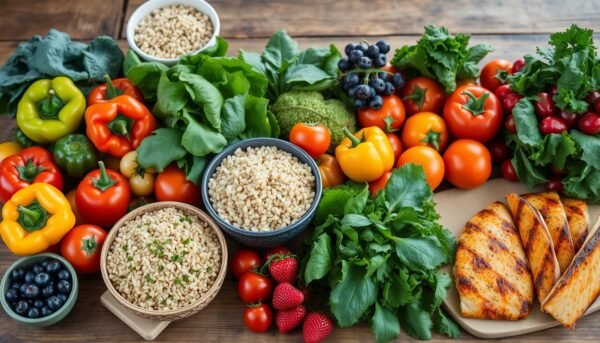I looked at the scale and felt frustrated and determined. The weight had slowly increased, weighing me down every day. I knew I had to change, but it seemed too hard.
Then, I found the 90-day weight loss challenge. It seemed like a good way to set goals and make lasting changes. It’s known that it takes 66 days for new habits to stick, making 90 days perfect for lasting changes.
Learning about 90-day transformations showed me many effective strategies. I learned about the psychology of habits, how to create a calorie deficit, and how to eat well. The path to success was becoming clear.
The 90-day challenge was more than just losing weight. It was about getting healthy, feeling more energetic, and living a sustainable lifestyle. With the right mindset, a good plan, and my family’s support, I was ready to start this journey.
Understanding the Science Behind 90-Day Weight Loss Transformations

Changing your body isn’t just about willpower or quick fixes. It’s a journey that needs you to understand the science of losing weight. Let’s explore the key principles for your 90-day weight loss journey.
The Psychology of Habit Formation
Habit formation is key to losing weight. Studies say it takes 66 days for a new behavior to become automatic. The 90-day timeline lets you adjust and form lasting healthy habits.
Why 90 Days is the Optimal Timeline
The 90-day mark is seen as the best time for weight loss changes. It gives enough time for habits to form and for noticeable progress. Losing 1-2 pounds per week fits well with this timeline.
Setting Realistic Transformation Goals
Setting realistic goals is crucial for your 90-day weight loss journey. Aim for a healthy weight loss range of 12-24 pounds in three months, as the CDC suggests. Remember, losing weight is about health, not just the number on the scale.
By understanding habit formation, the 90-day timeline, and setting realistic goals, you’re ready for your weight loss journey. Enjoy the journey, celebrate small wins, and focus on your health. The results will come.
Creating a Sustainable Caloric Deficit for Weight Loss

For lasting weight loss, focus on a calorie deficit. Cutting 500-1,000 calories daily can lead to 1-2 pounds lost weekly. But, don’t cut too many calories, as it can slow your metabolism.
Your daily calorie needs depend on height, weight, gender, age, and activity level. Use an online calculator or talk to a dietitian to find your calorie goal. Counting calories and choosing smart foods are key to a sustainable deficit.
| Gender | Recommended Calorie Range |
|---|---|
| Women | 1,200 – 1,500 calories |
| Men | 1,500 – 1,800 calories |
Drink plenty of water on a low-calorie diet. It helps you feel full and stops unnecessary snacking. Also, eat fruits, veggies, lean proteins, and whole grains. They help you stay in a calorie deficit and support sustainable weight loss and a healthy metabolism.
Consistency is crucial. Slow, steady changes in diet and exercise lead to lasting success. With the right strategy, you can reach your weight loss goals without harming your health.
Essential Losing Weight Tips for Long-Term Success

Getting to a healthy weight is more than just a number. It’s about changing your life for the better. Focus on feeling good, not just looking good. Manage your calories and control your portions to keep losing weight for good.
Tracking Progress Beyond the Scale
The scale is helpful, but don’t get too caught up in it. Look at how your clothes fit and how you feel. Take photos to see your progress. This way, you’ll stay motivated and celebrate your wins.
Managing Daily Calorie Intake
Keeping track of your calories is crucial. Eat fewer calories by choosing healthy foods. Stay away from sugary drinks and snacks. Eat lots of veggies, fruits, lean proteins, and whole grains.
Implementing Portion Control Strategies
- Use smaller plates to help manage portion sizes.
- Follow the 50-25-25 rule: fill half your plate with vegetables, a quarter with lean protein, and a quarter with complex carbohydrates.
- Be mindful of your hunger cues and stop eating when you feel satisfied, not full.
- Slow down and savor your meals to allow your body to register feelings of fullness.
By following these tips, you’ll be on the path to lasting success. Remember, losing weight is a journey, not a quick fix. Stay patient, consistent, and focus on your health. You’ll reach your goals and keep them for years.
| Metric | Recommendation |
|---|---|
| Weekly Weight Loss | 1 to 2 pounds (0.5 to 1 kilogram) |
| Vegetable Servings | At least 4 servings per day |
| Fruit Servings | At least 3 servings per day |
| Aerobic Exercise | At least 30 minutes most days of the week |
| Strength Training | At least 2 times per week |
The Mediterranean Approach to Weight Loss Success

The Mediterranean diet is great for losing weight in a healthy way. It’s been named the best diet for seven years in a row. It focuses on eating whole foods that are good for you.
This diet has about 40% carbs, 40% healthy fats, and 20% protein. It lets you enjoy pasta and bread a little, but also eat lots of veggies, fruits, and lean proteins. Studies show it’s especially good for losing weight.
People who follow this diet lose about 8.7% of their body weight. It also helps prevent weight gain and belly fat over time. Compared to a low-fat diet, it leads to more weight loss in a year.
The diet makes you feel full because of its fiber, protein, and healthy fats. Dairy products in the diet also help control hunger. Eating more veggies and whole grains can help you lose weight, even if you don’t eat less.
Following the Mediterranean diet means eating more plant-based foods and lean proteins. It’s okay to have sweets and red meat sometimes. This balanced way of eating helps you lose weight in a way that feels good.
Structuring Your Plate for Optimal Weight Loss

Weight loss is more than just eating less. It’s about finding a balance that feeds your body and helps you lose weight. The 50-25-25 rule for your plate can help you control food portions and get the right mix of nutrients.
The 50-25-25 Rule for Portion Control
The 50-25-25 rule means your plate should be split this way: 50% veggies, 25% protein, and 25% carbs. This way, you stay full and get all the nutrients you need.
Balancing Macronutrients Effectively
The 50-25-25 rule helps balance your meals. Lean proteins like chicken or fish help build muscle. Complex carbs like brown rice give you energy and fiber. And veggies are packed with vitamins and minerals.
Incorporating Nutrient-Dense Foods
Choosing foods high in nutrients is key for losing weight. Go for whole foods like leafy greens, berries, and nuts. These foods are good for you and keep you full, so you don’t overeat.
Using the 50-25-25 rule and eating nutrient-rich foods helps you lose weight in a healthy way. This balanced eating approach can change your weight loss journey for the better.
Strategic Meal Planning for Weight Loss

Starting a 90-day diet meal plan is key to losing weight for good. It helps you eat healthy, nutritious meals that fuel your body. Make sure to eat a variety of foods to avoid missing out on nutrients and to keep your meals interesting.
Choose quick, healthy meals to avoid fast food or unhealthy takeout. Try Mediterranean dishes for their taste and health benefits. Think of avocado toast, grain bowls, and whole grain pasta with veggies and light sauce.
| Meal | Calories | Protein (g) | Carbs (g) | Fat (g) |
|---|---|---|---|---|
| Breakfast: Oatmeal with Berries and Nuts | 350 | 12 | 45 | 15 |
| Lunch: Quinoa Salad with Grilled Chicken | 450 | 30 | 35 | 18 |
| Dinner: Baked Salmon with Roasted Vegetables | 400 | 25 | 20 | 22 |
Plan your meals ahead to always have healthy options. This helps you stay on track with your weight loss goals. Remember, being consistent and balanced is crucial for lasting success.
Building a Foundation with Whole Foods and Lean Proteins

Starting a lasting weight loss journey needs a strong base of whole foods and lean proteins. These key elements help you make a lasting change and support your body’s health.
Best Protein Sources for Weight Loss
Lean proteins are key for losing weight. They help you feel full, keep muscle, and boost your metabolism. Choose whole food proteins like:
- Lean cuts of poultry (chicken, turkey)
- Fatty fish (salmon, tuna, mackerel)
- Eggs
- Legumes (lentils, beans, peas)
- Greek yogurt
These foods will keep you full and give you energy as you lose weight.
Complex Carbohydrates Selection
Choose complex carbs that are high in fiber. They give you steady energy and help keep blood sugar levels healthy. Add whole grains, starchy veggies, and legumes to your meals, such as:
- Quinoa
- Brown rice
- Sweet potatoes
- Oats
- Lentils
These carbs will keep you full and stop energy crashes that can hurt your weight loss.
Healthy Fats Integration
Healthy fats are important for a balanced weight loss diet. Add sources of healthy fats like:
- Avocados
- Nuts and seeds
- Olive oil
- Fatty fish
These fats help you feel full, balance hormones, and help your body use vitamins. Eating whole foods and balancing macronutrients sets you up for lasting weight loss success.
| Whole Food Category | Examples | Benefits for Weight Loss |
|---|---|---|
| Lean Proteins | Chicken, turkey, fish, eggs, Greek yogurt, legumes | Promote satiety, preserve muscle mass, support metabolism |
| Complex Carbohydrates | Quinoa, brown rice, sweet potatoes, oats, lentils | Provide sustained energy, support healthy blood sugar levels |
| Healthy Fats | Avocados, nuts, seeds, olive oil, fatty fish | Promote satiety, support hormone balance, aid vitamin absorption |
Maintaining Motivation Through the 90-Day Journey

Starting a weight loss journey is exciting but also tough. As you go through the 90-day journey, keeping motivated is crucial for lasting success. Remember, the scale might not change fast, but focus on the good changes in your health and how you feel.
Creating new habits takes time. Being consistent is key to lasting weight loss. So, celebrate every small win. This could be a new personal best in your workout, more energy, or feeling more confident.
- Set realistic, specific goals that fit your life and likes. This keeps you focused and on track for 90 days.
- Build a support network of friends, family, or online groups. Sharing your journey makes it more fun and meaningful.
- Use tools like progress photos, measurements, and fitness trackers. Seeing real changes can really motivate you.
Weight loss is a journey, not just a goal. Focus on the journey, celebrate your wins, and surround yourself with positive people. This way, you’ll keep your weight loss motivation strong and reach long-term success in your habit formation.
Incorporating Cheat Meals Without Derailing Progress
Starting my 90-day weight loss journey, I’ve learned cheat meals are key. They keep me motivated and help me succeed in the long run. Up to 50% of competitive physique athletes use them before competitions. The 80/20 rule guides me to be strict 80% of the time and flexible 20%.
A short-term carb overload boosts my metabolism by nearly 30% for 24 hours. Eating a big meal can also make my body burn more calories later. I plan my big meals around my healthy breakfast, lunch, and snacks. This way, I enjoy my freedom while still losing weight.
To avoid setbacks, I use apps like Lose It! to track my calories. I also try to see my “cheat days” as “off days.” This helps me have a better relationship with food. By making my diet fit my needs, I’m sure I can enjoy cheat meals without losing my way.
This post may contain affiliate links which means I may receive a commission for purchases made through links. I will only recommend products that I have personally used! Learn more on my Private Policy page.